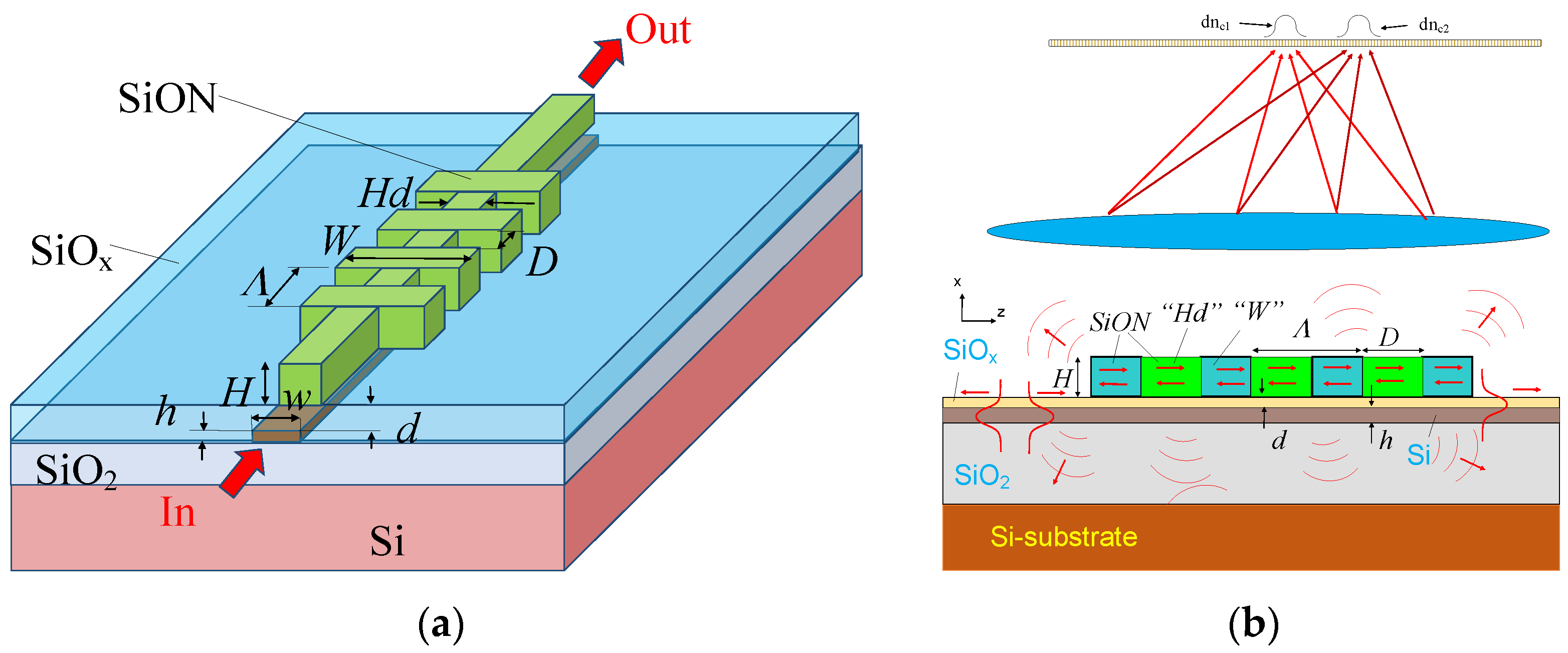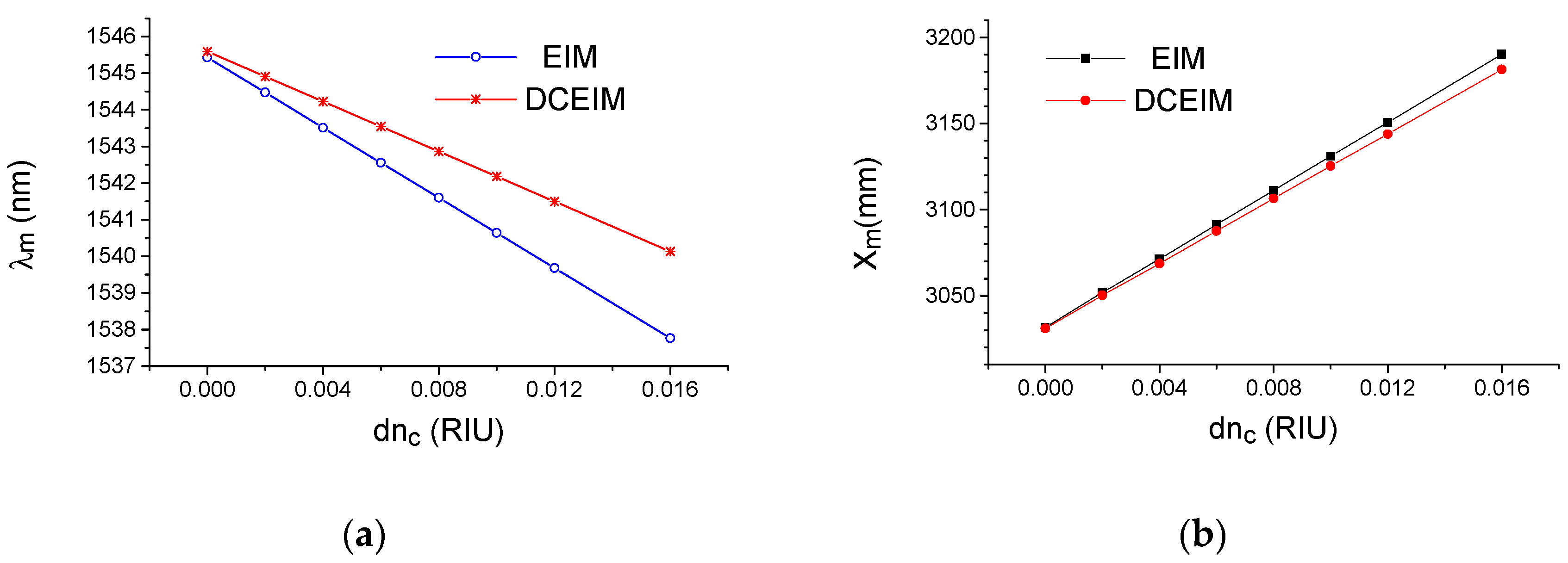Numerical Simulation of Optical Sensing by the Far Field Pattern Radiated by Periodic Grating Strips Over Silica Buffer on the Silicon Wire Waveguide
Abstract
1. Introduction
2. Sensor Design
3. Numerical Modeling
4. Conclusions
Author Contributions
Funding
Acknowledgments
Conflicts of Interest
References
- Tsarev, A. Overview of integrated optical sensors based on silicon—Forecasts and results of the decade. (Invited paper). Optoelectron. Instrum. Data Process. 2020, in press. Russian Text published in Avtometriya 2020, 56, 111–133. [Google Scholar]
- Fernández Gavela, A.; Grajales García, D.; Ramirez, J.C.; Lechuga, L.M. Last advances in silicon-based optical biosensors. Sensors 2016, 16, 285. [Google Scholar] [CrossRef]
- Steglich, P.; Hülsemann, M.; Dietzel, B.; Mai, A. Optical Biosensors Based on Silicon-On-Insulator Ring Resonators: A Review. Molecules 2019, 24, 519. [Google Scholar] [CrossRef] [PubMed]
- Luan, E.; Shoman, H.; Ratner, D.M.; Cheung, K.C.; Chrostowski, L. Silicon Photonic Biosensors Using Label-Free Detection. Sensors 2018, 18, 3519, Erratum in 2019, 19, 1161. [Google Scholar] [CrossRef]
- Xu, Y.; Hu, X.; Kundu, S.; Nag, A.; Afsarimanesh, N.; Sapra, S.; Mukhopadhyay, S.C.; Han, T. Silicon-Based Sensors for Biomedical Applications: A Review. Sensors 2019, 19, 2908. [Google Scholar] [CrossRef] [PubMed]
- Angelopoulou, M.; Kakabakos, S.; Petrou, P. Label-Free Biosensors Based onto Monolithically Integrated onto Silicon Optical Transducers. Chemosensors 2018, 6, 52. [Google Scholar] [CrossRef]
- Arshavsky-Graham, S.; Massad-Ivanir, N.; Segal, E.; Weiss, S. Porous silicon-based photonic biosensors: Current status and emerging applications. Anal. Chem. 2018, 91, 441–467. [Google Scholar] [CrossRef]
- Ghosh, S.; Dar, T.; Viphavakit, C.; Pan, C.; Kejalakshmy, N.; Rahman, B.M.A. Compact Photonic SOI Sensors. In Computational Photonic Sensors; Hameed, M., Obayya, S., Eds.; Springer: Cham, Switzerland, 2019; pp. 343–383. [Google Scholar]
- Chen, Y.; Liu, J.; Yang, Z.; Wilkinson, J.S.; Zhou, X. Optical biosensors based on refractometric sensing schemes: A review. Biosens. Bioelectron. 2019, 144, 111693. [Google Scholar] [CrossRef]
- Luan, E.; Yun, H.; Laplatine, L.; Dattner, Y.; Ratner, D.M.; Cheung, K.C.; Chrostowski, L. Enhanced sensitivity of subwavelength multibox waveguide microring resonator label-free biosensors. IEEE J. Sel. Top. Quantum Electron. 2019, 25, 7300211. [Google Scholar] [CrossRef]
- Mariani, S.; Strambini, L.M.; Paghi, A.; Barillaro, G. Low-Concentration Ethanol Vapor Sensing with Nanostructured Porous Silicon Interferometers Using Interferogram Average over Wavelength Reflectance Spectroscopy. IEEE Sens. J. 2018, 18, 7842–7849. [Google Scholar] [CrossRef]
- Lova, P.; Manfredi, G.; Bastianini, C.; Mennucci, C.; Buatier de Mongeot, F.; Servida, A.; Comoretto, D. Flory–Huggins Photonic Sensors for the Optical Assessment of Molecular Diffusion Coefficients in Polymers. ACS Appl. Mater. Interfaces 2019, 11, 16872–16880. [Google Scholar] [CrossRef] [PubMed]
- Cottier, K.; Wiki, M.; Voirin, G.; Gao, H.; Kunz, R.E. Label-free highly sensitive detection of (small) molecules by wavelength interrogation of integrated optical chips. Sens. Actuators B Chem. 2003, 91, 241–251. [Google Scholar] [CrossRef]
- Darwish, N.; Caballero, D.; Moreno, M.; Errachid, A.; Samitier, J. Multi-analytic grating coupler biosensor for differential binding analysis. Sens. Actuators B Chem. 2010, 144, 413–417. [Google Scholar] [CrossRef]
- Triggs, G.J.; Wang, Y.; Reardon, C.P.; Fischer, M.; Evans, G.J.; Krauss, T.F. Chirped guided-mode resonance biosensor. Optica 2017, 4, 229–234. [Google Scholar] [CrossRef]
- Passaro, V.M.N.; De Leonardis, F.; Tsarev, A.; Kolosovsky, E. Concept of Optical Sensor Utilising the Far Field Pattern Radiated by Periodic Grating Strips Over Silica Cladding on the Silicon Wire Waveguide. In Proceedings of the Ninth International Conference on Sensor Device Technologies and Applications, Venice, Italy, 16–20 September 2018; pp. 28–31, Best paper Award. [Google Scholar]
- Tsarev, A.; Kolosovsky, E.; De Leonardis, F.; Passaro, V.M.N. Numerical Simulation of a Novel Sensing Approach Based on Abnormal Blocking by Periodic Grating Strips near the Silicon Wire Waveguide. Sensors 2018, 18, 1707. [Google Scholar] [CrossRef]
- Tsarev, A.; De Leonardis, F.; Passaro, V.M.N. Numerical Modeling of Abnormal Blocking Effect for the Design of Novel Optical Sensor Element Constructed by Periodic Grating Strips Over Si/SiO2 Wire Waveguide. Phys. Status Solidi. A 2019, 216, 1800480. [Google Scholar] [CrossRef]
- Kolosovskii, E.A.; Tsarev, A.V. Abnormal blocking of a guided mode propagating in a silicon optical waveguide with periodic tunnel coupling. Quantum Electron. 2017, 47, 58–64. [Google Scholar] [CrossRef]
- Claes, T.; Girones Molera, J.; De Vos, K.; Schacht, E.; Baets, R.; Bienstman, P. Label-Free Biosensing With a Slot-Waveguide-Based Ring Resonator in Silicon on Insulator. IEEE Photonics J. 2009, 1, 197–204. [Google Scholar] [CrossRef]
- Yen, T.-H.; Hung, Y.-J. Narrowband dual-wavelength silicon waveguide Bragg reflectors. J. Light. Technol. 2019, 37, 5326–5332. [Google Scholar] [CrossRef]
- Maegami, Y.; Takei, R.; Omoda, E.; Amano, T.; Okano, M.; Mori, M.; Kamei, T.; Sakakibara, Y. Spot-size converter with a SiO2 spacer layer between tapered Si and SiON waveguides for fiber-to-chip coupling. Opt. Express 2015, 23, 21287–21295. [Google Scholar] [CrossRef]
- Sekimoto, T.; Ikuta, S.; Pan, W.; Chu, S.T.; Kokubun, Y. Vertical antiresonant reflecting optical waveguide coupler for three-dimensional optical interconnects: Optimum design for large tolerance, high coupling efficiency, and short coupling length. Appl. Opt. 2000, 39, 426–430. [Google Scholar] [CrossRef] [PubMed]
- Vaskevicius, K.; Gabalis, M.; Urbonas, D.; Balcytis, A.; Petruskevicius, R.; Juodkazis, S. Enhanced sensitivity and measurement range SOI microring resonator with integrated one-dimensional photonic crystal. J. Opt. Soc. Am. B 2017, 34, 750–755. [Google Scholar] [CrossRef]
- Rsoft FullWave by SYNOPSYS. Photonic Design Software. Available online: https://www.synopsys.com/optical-solutions/rsoft.html (accessed on 18 January 2018).
- Chiang, K.S. Dual effective-index method for the analysis of rectangular dielectric waveguides. Appl. Opt. 1986, 25, 2169–2174. [Google Scholar] [CrossRef] [PubMed]
- Tsarev, A. Modified effective index method to fit the phase and group index of 3D photonic wire waveguide. Opt. Lett. 2013, 38, 293–295. [Google Scholar] [CrossRef]
- O’Faolain, L.; Tsarev, A. Experimental demonstration of original optical filter based on multiply coupled waveguides. Opt. Lett. 2014, 39, 3627–3629. [Google Scholar] [CrossRef]
- Hu, J.; Sun, X.; Agarwal, A.; Kimerling, L.C. Design guidelines for optical resonator biochemical sensors. JOSA B. 2009, 26, 1032–1041. [Google Scholar] [CrossRef]
- Vos, K.; Bartolozzi, I.; Schacht, E.; Bienstman, P.; Baets, R. Silicon-on-insulator microring resonator for sensitive and label-free biosensing. Opt. Express 2007, 15, 7610–7615. [Google Scholar] [CrossRef]
- Xu, Y.; Bai, P.; Zhou, X.; Akimov, Y.; Png, C.E.; Ang, L.K.; Knoll, W.; Wu, L. Optical Refractive Index Sensors with Plasmonic and Photonic Structures: Promising and Inconvenient Truth. Adv. Opt. Mater. 2019, 7, 1801433. [Google Scholar] [CrossRef]
- Pitruzzello, G.; Krauss, T.F. Photonic crystal resonances for sensing and imaging. J. Opt. 2018, 20, 073004. [Google Scholar] [CrossRef]
- Wang, X.; Flueckiger, J.; Schmidt, S.; Grist, S.; Fard, S.T.; Kirk, J.; Doerfler, M.; Cheung, K.C.; Ratner, D.M.; Chrostowski, L. A silicon photonic biosensor using phase-shifted Bragg gratings in slot waveguide. J. Biophotonics 2013, 6, 821–828. [Google Scholar] [CrossRef]



© 2020 by the authors. Licensee MDPI, Basel, Switzerland. This article is an open access article distributed under the terms and conditions of the Creative Commons Attribution (CC BY) license (http://creativecommons.org/licenses/by/4.0/).
Share and Cite
Tsarev, A.; Passaro, V.M.N. Numerical Simulation of Optical Sensing by the Far Field Pattern Radiated by Periodic Grating Strips Over Silica Buffer on the Silicon Wire Waveguide. Sensors 2020, 20, 5306. https://doi.org/10.3390/s20185306
Tsarev A, Passaro VMN. Numerical Simulation of Optical Sensing by the Far Field Pattern Radiated by Periodic Grating Strips Over Silica Buffer on the Silicon Wire Waveguide. Sensors. 2020; 20(18):5306. https://doi.org/10.3390/s20185306
Chicago/Turabian StyleTsarev, Andrei, and Vittorio M. N. Passaro. 2020. "Numerical Simulation of Optical Sensing by the Far Field Pattern Radiated by Periodic Grating Strips Over Silica Buffer on the Silicon Wire Waveguide" Sensors 20, no. 18: 5306. https://doi.org/10.3390/s20185306
APA StyleTsarev, A., & Passaro, V. M. N. (2020). Numerical Simulation of Optical Sensing by the Far Field Pattern Radiated by Periodic Grating Strips Over Silica Buffer on the Silicon Wire Waveguide. Sensors, 20(18), 5306. https://doi.org/10.3390/s20185306





